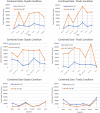Investigating Gaze Behaviour of Children Diagnosed with Autism Spectrum Disorders in a Classroom Setting
- PMID: 33590429
- PMCID: PMC8531110
- DOI: 10.1007/s10803-021-04906-z
Investigating Gaze Behaviour of Children Diagnosed with Autism Spectrum Disorders in a Classroom Setting
Abstract
A defining feature of ASD is atypical gaze behaviour, however, eye-tracking studies in 'real-world' settings are limited, and the possibility of improving gaze behaviour for ASD children is largely unexplored. This study investigated gaze behaviour of ASD and typically developing (TD) children in their classroom setting. Eye-tracking technology was used to develop and pilot an operant training tool to positively reinforce typical gaze behaviour towards faces. Visual and statistical analyses of eye-tracking data revealed different gaze behaviour patterns during live interactions for ASD and TD children depending on the interaction type. All children responded to operant training with longer looking times observed on face stimuli post training. The promising application of operant gaze training in ecologically valid settings is discussed.
Keywords: Applied behaviour analysis; Autism; Behaviour change; Eye-tracking; Gaze behaviour; Social skills.
© 2021. The Author(s).
Conflict of interest statement
Authors have no conflict of interests to declare.
Figures







Similar articles
-
Gazefinder as a clinical supplementary tool for discriminating between autism spectrum disorder and typical development in male adolescents and adults.Mol Autism. 2016 Mar 23;7:19. doi: 10.1186/s13229-016-0083-y. eCollection 2016. Mol Autism. 2016. PMID: 27011784 Free PMC article.
-
Promoting social attention in 3-year-olds with ASD through gaze-contingent eye tracking.Autism Res. 2020 Jan;13(1):61-73. doi: 10.1002/aur.2199. Epub 2019 Aug 30. Autism Res. 2020. PMID: 31468735 Free PMC article. Clinical Trial.
-
Atypical gaze patterns to facial feature areas in autism spectrum disorders reveal age and culture effects: A meta-analysis of eye-tracking studies.Autism Res. 2021 Dec;14(12):2625-2639. doi: 10.1002/aur.2607. Epub 2021 Sep 20. Autism Res. 2021. PMID: 34542246
-
Eye Gaze in Autism Spectrum Disorder: A Review of Neural Evidence for the Eye Avoidance Hypothesis.J Autism Dev Disord. 2023 May;53(5):1884-1905. doi: 10.1007/s10803-022-05443-z. Epub 2022 Feb 4. J Autism Dev Disord. 2023. PMID: 35119604 Free PMC article. Review.
-
The uses of cognitive training technologies in the treatment of autism spectrum disorders.Autism. 2014 Nov;18(8):851-71. doi: 10.1177/1362361313499827. Epub 2013 Oct 15. Autism. 2014. PMID: 24129912 Review.
Cited by
-
Behavioral Intervention for Adults With Autism on Distribution of Attention in Triadic Conversations: A/B-Tested Pre-Post Study.JMIR Form Res. 2024 Aug 12;8:e55339. doi: 10.2196/55339. JMIR Form Res. 2024. PMID: 39133914 Free PMC article.
-
The Components of Interpersonal Synchrony in the Typical Population and in Autism: A Conceptual Analysis.Front Psychol. 2022 Jun 6;13:897015. doi: 10.3389/fpsyg.2022.897015. eCollection 2022. Front Psychol. 2022. PMID: 35734455 Free PMC article. Review.
-
The Bidirectional Social-Cognitive Mechanisms of the Social-Attention Symptoms of Autism.Front Psychiatry. 2022 Jan 31;12:752274. doi: 10.3389/fpsyt.2021.752274. eCollection 2021. Front Psychiatry. 2022. PMID: 35173636 Free PMC article.
-
A Scoping Review of Behavioral Interventions for Promoting Social Gaze in Individuals with Autism Spectrum Disorder and Other Developmental Disabilities.Res Autism Spectr Disord. 2023 Feb;100:102074. doi: 10.1016/j.rasd.2022.102074. Epub 2022 Nov 22. Res Autism Spectr Disord. 2023. PMID: 36843962 Free PMC article.
-
Correlation Between Gaze Behaviors and Social Communication Skills of Young Autistic Children: A Meta-Analysis of Eye-Tracking Studies.J Autism Dev Disord. 2025 Mar;55(3):843-861. doi: 10.1007/s10803-024-06257-x. Epub 2024 Feb 24. J Autism Dev Disord. 2025. PMID: 38400896
References
-
- Adamson LB, Bakeman R. Mothers' communicative acts: Changes during infancy. Infant Behavior and Development. 1984;7(4):467–478. doi: 10.1016/S0163-6383(84)80006-5. - DOI
MeSH terms
LinkOut - more resources
Full Text Sources
Other Literature Sources
Medical

